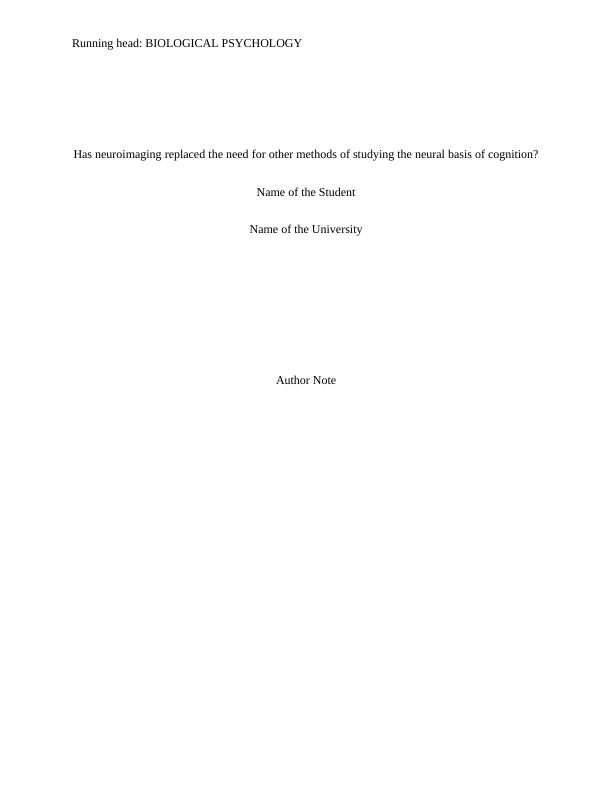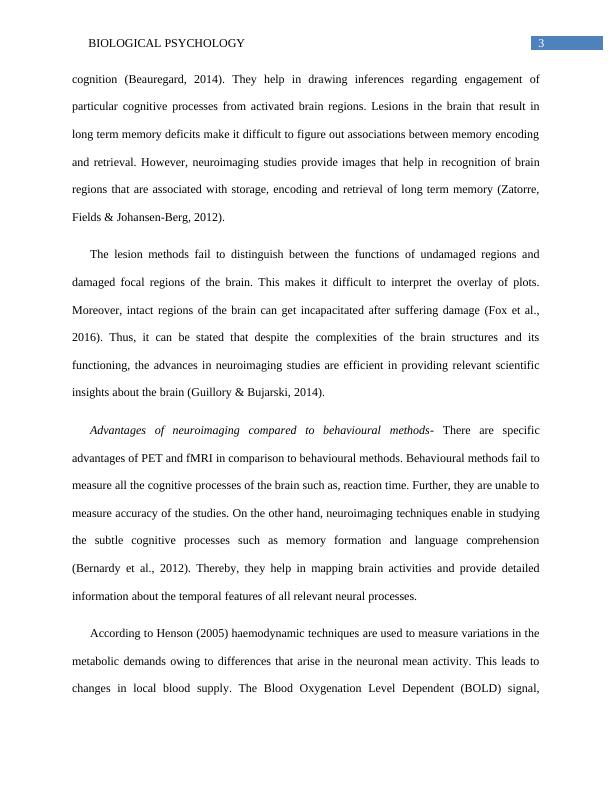Biological Psychology Assignment
Added on 2020-04-15
13 Pages3497 Words109 Views
Running head: BIOLOGICAL PSYCHOLOGYHas neuroimaging replaced the need for other methods of studying the neural basis of cognition?Name of the StudentName of the UniversityAuthor Note

1BIOLOGICAL PSYCHOLOGYIntroduction- Neuroimaging refers to various techniques that involve brain-scanning andassist in observing the different levels of activity in the brain of a participant while they areperforming some psychological tasks. These techniques are used to directly or indirectly createan image of the structure, function and pharmacology of the nervous system (de Notaris et al.,2013). Various attempts had been taken towards the end of nineteenth century, to discover thedifferent mental processes that drive all human functions and behavior. It was a commonassumption that mental processing in the brain is unconsciously produced. Reaction time andresponse accuracies were used to study this field. The neural basis of cognition was studiedamong patients who suffered from brain damage in the 1970s and the assumption was made thatbrains are composed of modules that are arranged in a structural and functional pattern. Thehistory of neuroimaging began with the use of pneumoencephalography in the 1990s (Webb,2013). This altered the relative density of the brain and a better x-ray image was obtained.Position Emission Tomography (PET), Computed tomography (CT) and functional MagneticResonance Imaging (fMRI) scans are the most commonly used neuroimaging techniques used tostudy neural cognition. This essay will illustrate the advantages and disadvantages ofneuroimaging techniques and whether it can be considered as the best method to detect mentalprocesses.Advantages of neuroimaging techniques- Functional techniques are considered as themainstay in studying cognitive neuroscience owing to their ability to help us in determining theassociation of neural activity in the brain with the ability to perform complex cognitive tasks. Italso determines the neural activity during illness (Wintermark et al., 2015). This approach worksby identifying and isolating the different brain structures that are involved in complex cognitive

2BIOLOGICAL PSYCHOLOGYprocesses. These techniques produce images of the brain, without the requirement of any skinincision, surgery, or direct contact with the internal organs of the body. The major advantage ofthese techniques lies in the fact that they are noninvasive procedures that result in visualizationof the entire structure and functionality of human brain. The neuroimaging techniques help in comparing the activation levels among differentsubjects and further assists in discovering the association between performance levels among thesubjects and their level of activation (Boly et al., 2016). In addition, the technique can also beutilized to compare between various trials that further helps in associating the activated regionsof the brain with presence of errors in the trial. Generally, two types of imaging agents are usedfor these studies.Passive agents, which modulate an external signals. Higher doses of passive contrastagents are used to delineate endogenous contrasts. Probes such as, bioluminescent dyes and radiotracers that produce autonomous signals.Some fluorescent probes and MRI contrast agents lead to transformation of an externalsignal (Simó et al., 2013). Furthermore, the techniques help to demonstrate that human beings not suffering from anyneurological damage or lesions are able to recruit specific regions of the brain to carry outcognitive processes. Advantages of neuroimaging in neuropsychological studies- Neuropsychological studiesfocus on the structure and function of the brain and relate them to human behavior andpsychological processes. However, they do not concentrate on the cognitive processes of thebrain. Neuroimaging studies overcome this drawback and help to gain a better understanding of

3BIOLOGICAL PSYCHOLOGYcognition (Beauregard, 2014). They help in drawing inferences regarding engagement ofparticular cognitive processes from activated brain regions. Lesions in the brain that result inlong term memory deficits make it difficult to figure out associations between memory encodingand retrieval. However, neuroimaging studies provide images that help in recognition of brainregions that are associated with storage, encoding and retrieval of long term memory (Zatorre,Fields & Johansen-Berg, 2012). The lesion methods fail to distinguish between the functions of undamaged regions anddamaged focal regions of the brain. This makes it difficult to interpret the overlay of plots.Moreover, intact regions of the brain can get incapacitated after suffering damage (Fox et al.,2016). Thus, it can be stated that despite the complexities of the brain structures and itsfunctioning, the advances in neuroimaging studies are efficient in providing relevant scientificinsights about the brain (Guillory & Bujarski, 2014). Advantages of neuroimaging compared to behavioural methods- There are specificadvantages of PET and fMRI in comparison to behavioural methods. Behavioural methods fail tomeasure all the cognitive processes of the brain such as, reaction time. Further, they are unable tomeasure accuracy of the studies. On the other hand, neuroimaging techniques enable in studyingthe subtle cognitive processes such as memory formation and language comprehension(Bernardy et al., 2012). Thereby, they help in mapping brain activities and provide detailedinformation about the temporal features of all relevant neural processes. According to Henson (2005) haemodynamic techniques are used to measure variations in themetabolic demands owing to differences that arise in the neuronal mean activity. This leads tochanges in local blood supply. The Blood Oxygenation Level Dependent (BOLD) signal,

End of preview
Want to access all the pages? Upload your documents or become a member.
Related Documents
Psychology: Understanding the Emergent Properties of the Brainlg...
|5
|847
|450
Functional Magnetic Resonance Imaging Technique: Researchlg...
|9
|3256
|225
Functional Brain Imaging in Cognitive Studies: PET and ECG Techniqueslg...
|9
|1887
|116
